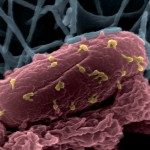Link to Pubmed [PMID] – 39231967
Link to HAL – pasteur-04688762
Link to DOI – 10.1038/s41467-024-51946-x
Nature Communications, 2024, 15 (1), pp.7702. ⟨10.1038/s41467-024-51946-x⟩
The human gut virome, which is mainly composed of bacteriophages, also includes viruses infecting archaea, yet their role remains poorly understood due to lack of isolates. Here, we characterize a temperate archaeal virus (MSTV1) infecting Methanobrevibacter smithii, the dominant methanogenic archaeon of the human gut. The MSTV1 genome is integrated in the host chromosome as a provirus which is sporadically induced, resulting in virion release. Using cryo-electron tomography, we capture several intracellular virion assembly intermediates and confirm that only a small fraction of the host population actively produces virions in vitro. Similar low frequency of induction is observed in a mouse colonization model, using mice harboring a stable consortium of 12 bacterial species (OMM12). Transcriptomic analysis suggests a regulatory lysogeny-lysis switch involving an interplay between viral proteins to maintain virus-host equilibrium, ensuring host survival and viral persistence. Thus, our study sheds light on archaeal virus-host interactions and highlights similarities with bacteriophages in establishing stable coexistence with their hosts in the gut.












